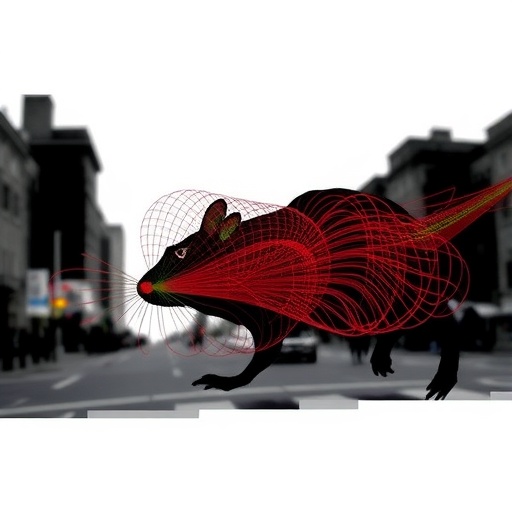In an innovative approach that could reshape urban wildlife studies, researchers have employed distributed acoustic sensing (DAS) technology to unravel the behavioral patterns of urban rat populations. This breakthrough research, led by Wang, Z., Zhang, CC., and Le Maho, Y., has been published in the journal Communications Earth & Environment. It opens a new window into understanding rodent dynamics through the lens of environmental intelligence captured via dark fiber networks.
The use of distributed acoustic sensing is revolutionary in wildlife monitoring, particularly in urban settings where traditional observation methods often fall short. DAS utilizes existing fiber optic cables to detect minute vibrations, transforming them into insightful data regarding movement patterns and behaviors of urban animals. Through this technology, the researchers were able to monitor rats in real-time, providing a comprehensive look at their interactions with the urban environment.
In urban areas, rats are notorious for their adaptability, often thriving in environments heavily modified by humans. This adaptability presents significant challenges to urban health and safety, as these rodents can be carriers of diseases. Understanding their dynamics offers crucial insights into public health strategies and pest control efforts. The researchers’ findings not only map the geographical distribution of rats but also illustrate their behavioral shifts in response to environmental factors and urban infrastructures, such as construction activities and public transportation systems.
One striking aspect of the research is the capability of DAS to collect consistent data over extended periods. Traditional traps or observational studies can only capture a snapshot of rat behavior, often missing the bigger picture. DAS, on the other hand, provides a continuous stream of data, yielding insights into the nocturnal activities of rats, which are often undetected in conventional studies. This long-term monitoring approach allows researchers to identify patterns of movement, including peak activity times and specific pathways, leading to a better understanding of rat distribution across different urban locales.
Furthermore, the integration of environmental intelligence into the study enhances the reliability of the data collected. By capturing environmental noise and correlating it with rat activities, researchers can distinguish between different types of disturbances, such as those created by human activities versus those created by other wildlife. This differentiation is vital for creating targeted urban management strategies that mitigate the effects of rat populations while considering the broader ecological context.
As the study progressed, researchers also observed the impact of seasonal changes on rat behavior. During warmer months, rats exhibited increased activity levels and shifted their foraging patterns. This seasonal variance emphasizes the need for dynamic management strategies that can adapt to the fluctuating habits of urban wildlife. By acknowledging these environmental influences, urban planners can develop more effective interventions aimed at reducing wildlife-human conflicts.
The findings from this groundbreaking study not only underscore DAS as a potent tool in urban ecology but also provide a model that can be replicated for other species. The implications of this research can extend beyond rat dynamics to include a variety of urban wildlife, offering insights that could transform how we approach the management of urban ecosystems. With rising urbanization and habitat modification, understanding the complexities of urban wildlife interactions becomes increasingly critical to fostering coexistence between humans and nature.
In addition to its ecological implications, the research also raises important questions about urban planning and public policy. As cities expand and evolve, integrating biological monitoring into the development framework could lead to more sustainable urban ecosystems. The precise tracking of urban rat populations and their behaviors could provide invaluable data for city planners, enabling them to design spaces that consider wildlife pathways and minimize conflict.
Moreover, this approach could also spearhead citizen engagement and education initiatives. As community members become more aware of their local wildlife dynamics, they can become active participants in managing their urban environments. This research highlights the interconnectedness of urban life and the importance of fostering a symbiotic relationship with local ecosystems.
In sum, the recent work by Wang, Z., Zhang, CC., and Le Maho, Y. represents a significant advancement in understanding urban wildlife dynamics through the lens of technology. The implementation of distributed acoustic sensing not only enriches ecological research but also equips urban planners, policymakers, and community members with the knowledge necessary to navigate the complexities of human-wildlife interactions. With more cities likely to adopt similar methodologies, the potential for creating more harmonious urban environments is vast. The implications of this research extend far beyond rats, inspiring a future where technology and ecological understanding converge for the betterment of urban ecosystems.
The findings from this study remind us that even in our crowded cities, wildlife continues to thrive and adapt. Through innovative approaches like distributed acoustic sensing, we gain the ability to witness and understand these adaptations, allowing us to forge a path toward coexistence with the myriad species that share our urban landscapes. As cities continue to grow, understanding and managing urban wildlife will be critical in creating sustainable, healthy environments for both people and animals alike.
By employing cutting-edge technologies and embracing an interdisciplinary approach, this research offers hope for the future of urban wildlife management, providing tools that empower communities and influence policy decisions. The journey towards achieving a balance between urban development and ecological preservation is challenging, but with studies like this, we are one step closer to realizing that vision in harmony with nature.
Subject of Research: Urban rat dynamics and behavior through distributed acoustic sensing technology.
Article Title: Distributed acoustic sensing reveals urban rat dynamics through environmental intelligence of dark fiber.
Article References:
Wang, Z., Zhang, CC., Le Maho, Y. et al. Distributed acoustic sensing reveals urban rat dynamics through environmental intelligence of dark fiber.
Commun Earth Environ 6, 956 (2025). https://doi.org/10.1038/s43247-025-02904-y
Image Credits: AI Generated
DOI: https://doi.org/10.1038/s43247-025-02904-y
Keywords: Urban wildlife, Distributed acoustic sensing, Rat dynamics, Environmental intelligence, Dark fiber technology.




